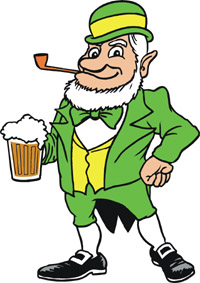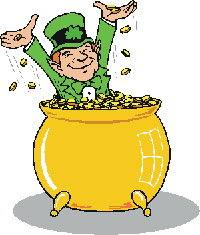Leprechauns, whose legends date back to the ancient Celts, are a race of fairies whose main occupation is to make shoes for themselves and all the other fairies. Since fairies love to dance, these shoes wear out quickly. Leprechauns are also the bankers of the fairy world, guarding treasure and doling out what is needed. They have no lack of gold, for their prodigious memories recall the time when marauding Danes buried their treasure in Ireland.
The word leprechaun (luprachán in Gaelic) means small-bodied. A leprechaun stands about two feet tall and looks like a little old man, his face wrinkled, but his eyes bright with mischief. He is clothed in green, wears a leather apron, a cocked hat, and shoes with buckles. Leprechauns are all male—which might explain their tendency to be grumpy. These mischievous pranksters enjoy drinking beer made from heath (a secret recipe from the Danes), and smoking their stump pipes, called dúidíns.
 According
to Irish folklore, a leprechaun must reveal his treasure to anyone who
can catch him. The best time is when he is intoxicated, and once caught,
he must never be let out of sight or he will vanish in an instant. The
captured leprechaun will try to bribe his way to freedom, and for that
reason carries a pouch with two coins inside; one, a silver shilling,
reappears in the pouch each time it is spent, while the other, a gold
coin, turns to ashes or leaves upon his release.
According
to Irish folklore, a leprechaun must reveal his treasure to anyone who
can catch him. The best time is when he is intoxicated, and once caught,
he must never be let out of sight or he will vanish in an instant. The
captured leprechaun will try to bribe his way to freedom, and for that
reason carries a pouch with two coins inside; one, a silver shilling,
reappears in the pouch each time it is spent, while the other, a gold
coin, turns to ashes or leaves upon his release. Rainbows present problems for the leprechauns, as they adhere themselves to pots of gold and follow them wherever they go. Thus, at the end of a rainbow, you will find the pot of gold—but if you have ever tried chasing a rainbow, you know how elusive it is. This is because the leprechauns are forever moving their precious gold to new hiding places, away from mortals who seek their treasures.
Many stories are told of those who have battled wits with a leprechaun. Once a man from the county of Cork captured a leprechaun and forced him to reveal his treasure. Since a leprechaun can never refuse, he led the man to a tree beneath which the gold was buried. The man marked the tree with a red scarf, planning to return with a shovel, and made the leprechaun promise not to touch it. The leprechaun, true to his word, left the scarf, but when the man returned, he found a red scarf tied to every tree in the area.
So, when you travel through Ireland, be on the lookout for leprechauns. Listen for the “tic...tac...tic...tac” of the little hammer—and perhaps, under a leaf, you'll find a wee little man working on a tiny pair of shoes. If you can catch and outwit him, you may come back a billionaire!
Click Here for information on our Ireland Bicycle and Walking Tours.



